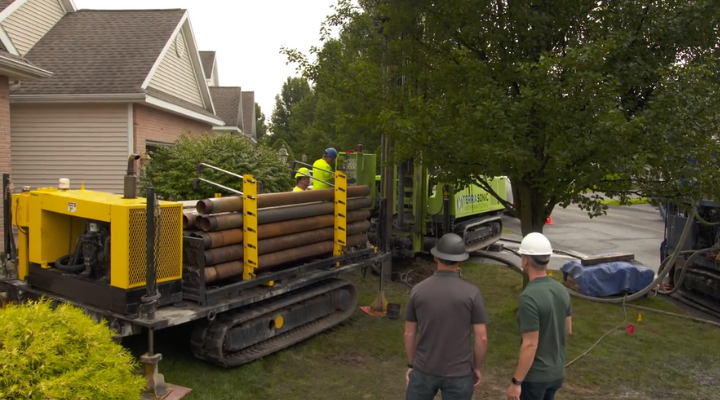Geothermal heat pumps owe their unparalleled efficiency to the fact that the earth maintains a more or less stable temperature profile regardless of the season or weather happening up at the surface. As you would imagine, the deeper the depth, the less impacted the earth’s temperature is by the weather conditions above. In a closed loop geothermal system, water flows through a ground loop circuit, traveling through the stable underground environment, absorbing heat in the winter, and dispersing heat in the summer as it goes. Engineers often perform a geothermal borehole depth calculation to determine how deep the system should go to achieve maximum efficiency. As the ground loop adds or subtracts more and more heat to or from the ground throughout a given season, the ground loop heats or cools the ground around it.
Seasonal Impacts on Ground Loop Temperatures
The coldest time period for the ground loop and the ground around it is early spring, because the system has been pulling heat out of the ground all winter. Similarly, the ground loop and the surrounding ground reach their warmest point in late fall, because the system transfers heat into the ground all summer. Engineers use an equation to calculate the proper length of a geothermal ground loop (and the borehole needed to contain it), ensuring the water flowing through the loop stays within an acceptable temperature band. In other words, the equation solves for the length of borehole required so the water within it doesn’t get too hot or too cold, in order that the heat pump within the home maintains its rated performance.
Ground Loop Design Temperature Ranges
The acceptable temperature range, the definition of what exactly is ‘too hot’ and ‘too cold’, is specified by the geothermal heat pump manufacturer, because the ground loop itself doesn’t “care” what the water temperature is – it’s the heat pump that “cares.” For many geothermal heat pumps, the manufacturers’ target range is 30F to 90F (note that even with this target range, the system will still run well a few degrees colder or warmer – these temperatures are targets). The equation used to find the appropriate length of a geothermal borehole solves for the length of borehole required so that the water running through the ground loop within it is unlikely to get much colder than 30F or warmer than 90F.
Key Factors That Influence Borehole Length
Many factors influence how much ground loop is needed to stay within this temperature range:
- The amount of heating and cooling the home will need. This depends on the local weather (colder climates require more heating), the home’s size, insulation, set point temperatures, and building materials. This is formally referred to as the “heating load” and the “cooling load” of the home.
- How readily the ground around the borehole gives up or accepts heat. Some materials are very good at transmitting heat. Think of a steel frying pan, for example. Some materials do not transmit heat as readily. Think of the rubber handle on that frying pan, for example. While not as extreme as steel vs rubber, the ground also has some materials within it, like bedrock, that are highly conductive, and other materials, like clay, that are less so. We formally refer to this as the “thermal conductivity” of the ground. We also consider the thermal conductivity of the grout surrounding the ground loop and of the ground loop itself for the same reason.
- The size and geometry of the ground loop within the borehole. A given length of ground loop with a larger diameter will transmit more heat than the same length of a smaller diameter ground loop because a larger diameter ground loop has more surface area that is in physical contact with the ground surrounding it.
- The relative spacing of ground loops if there is more than one. If you have two ground loops and they are close to each other, they might impact each other’s heat exchange, because they are both cooling or heating the same area of ground. Therefore, designers must increase the loop length to compensate an not interfere.
The Borehole Depth Calculation Formula
With those factors explained, this is what the equation looks like for geothermal borehole depth calculation:

Where:
- LH,T is the total borehole design length for heating. This is the value we solve for to ensure the borehole provides enough heat for the home. A similar equation exists for cooling, but in the Northeast, the heating requirement typically governs borehole length, so if a borehole is long enough for heating, it will also be sufficient for cooling.
- HCD is the heat pump’s heating capacity at design conditions (Btu/hr), defined by the manufacturer.
- COPD is the coefficient of performance at design heating conditions, also defined by the manufacturer.
- RB is the borehole thermal resistance (hr·ft·°F/Btu), based on ground loop and grout properties.
- RG is the steady-state thermal resistance of the surrounding ground, calculated using installation data and geological sources.
- FH is the run fraction in heating mode during January, representing how often the heat pump runs in the coldest month.
- TG is the average ground temperature along the borehole, determined from geological data.
- EWTmin is the minimum entering water temperature at heating design conditions (30°F).
- LWTmin is the minimum leaving water temperature at heating design conditions, derived from manufacturer performance tables.
The geothermal industry recognizes this as the gold standard. IGSHPA, the International Ground Source Heat Pump Association endorses it as the loop design best practice, and engineers have used it to design geothermal loops across the United States for decades.
How Geology and Climate Affect Borehole Design
Because weather and geology vary tremendously across the Northeast, some areas require substantially longer boreholes than others. For example, Westchester County, NY tends to have lots of bedrock, which is highly conductive. Whereas, Southern Vermont has many areas with less conductive geology. Because Southern Vermont has less conductive geology and colder weather than Westchester County, we typically see longer ground loop requirements in Southern Vermont than we do in Westchester County.
Best Practices vs. Rule of Thumb in Ground Loop Design
Dandelion follows industry-accepted best practices for loop design instead of relying on “rule of thumb” shortcuts. We aim to deliver long-lasting, high-quality geothermal systems to homeowners. A rule of thumb, such as the common “150 feet of borehole per ton of capacity,” ignores critical factors like pipe diameter (1.25″ vs. 1.5″) and whether the system uses a single or double loop. You also have to consider, how conductive is the grout? Is that 150 feet based on heating tons or cooling tons? Is the geology in the area primarily clay or bedrock? How efficient is the heat pump being installed? etc. All of these factors determine how much ground loop a system needs, but a rule-of-thumb method ignores them. As a result, the homeowner either pays for unnecessarily long (and expensive) ground loops or ends up without enough loop.
Does a Longer Ground Loop Improve Efficiency?
Building on the point above, customers often ask us: “If we install a longer ground loop than the 30F to 90F temperature range requires, will my heat pump be more efficient?”
The technical answer is “yes.” A longer ground loop makes the heat pump more efficient, but the returns diminish quickly. For example, if a homeowner installs 50% more ground loop than typically prescribed for a 30F minimum water temperature, the minimum water temperature rises to 36°F instead of the targeted 30°F. The Coefficient of Performance (COP) of one of the heat pump models Dandelion typically installs when it’s operating at 30F is 3.92, whereas the COP of this unit operating at 36 degrees F is 4.17. Assuming electricity costs 25 cents per kWh, a homeowner in the northeast with a 5T heat pump and a 50% longer-than-standard ground loop would pay, on average, about $15 less per month on their electricity bill. However, the cost premium for a 50% longer ground loop is around $10,000.
As you can see, the payback on this longer loop does not make financial sense, and it can be the difference between a geothermal system that saves a homeowner money and one that does not. So it is important to install the correct amount of loop, and therefore not to overcharge the homeowner.
Dandelion’s Commitment to Quality
Dandelion is committed to installing the correct amount of ground loop for every customer. Each system Dandelion installs comes with a 1-year Workmanship Warranty, so we contractually commit to our customers that if there is an error in the design or installation of their geothermal system, we will fix it at no cost to the customer. To achieve our mission of delivering high-quality, cost-effective geothermal systems at scale, Dandelion adheres to professional, engineering, and science-based design standards and guarantees homeowners the highest degree of quality.

